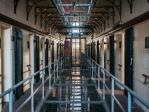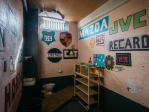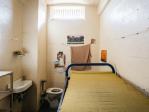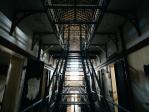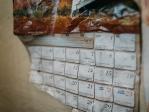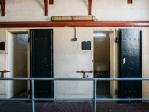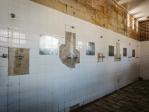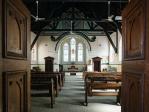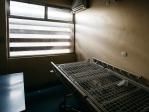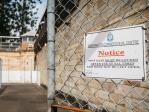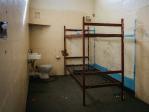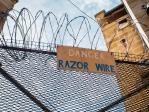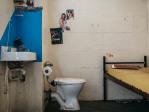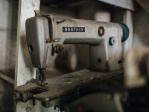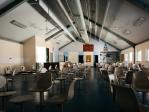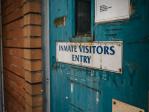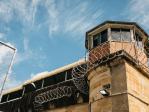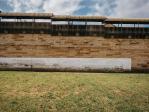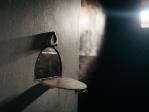
Parramatta gaol, which has been operating since 1798, was decommissioned in 2011. Picture: Tim Frawley for news.com.au
WHAT happened to you, Baby Joe Redmond?
How did you end up here, in this dank and tiny prison cell on the second floor at the former Parramatta Gaol?
I’m Looking at two yellowed envelopes stuck to the wall alongside torn-out magazine images of porn stars and empty boxes of Redheads matches, and it’s impossible not to wonder.
Along with photographer Tim Frawley and a security guard, I’m walking around the disused Parramatta prison site. The sandstone exterior is striking. The interior is a different story.
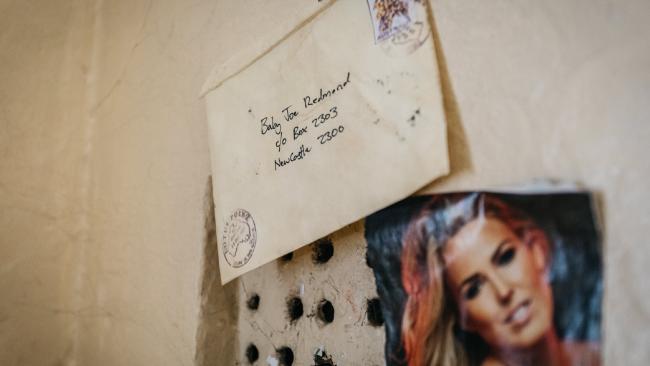
A letter is stuck to one of the cell walls addressed to Baby Joe Redmond in Newcastle. Picture: Tim Frawley for news.com.auSource:news.com.au
The security guard, who comes here once a week, quietly tells me that sometimes he hears voices or music, which just isn’t there.
“I feel the coldness here sometimes,” he says, “it’s not haunted but there are spirits.”
No matter what you believe, it’s hard not to be affected by this oppressive place.
As we walk the sharp echoes of our feet on the grey, concrete floor ring out. Tim mutters: “It such a bright sunny day outside, but in here it’s so dark.”
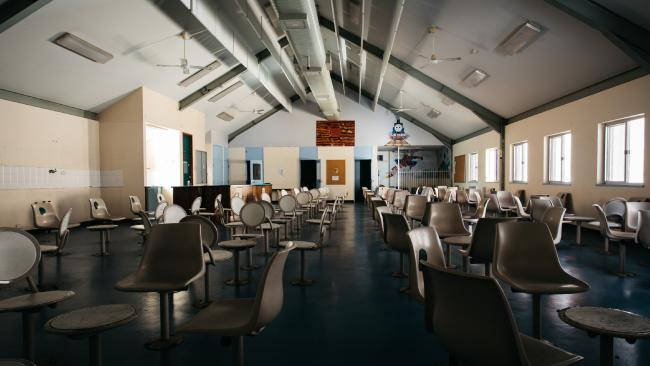
The abandoned common area. Picture: Tim Frawley for news.com.auSource:news.com.au
“I wouldn’t want to spend the night here, let alone years,” he adds a few minutes later.
The three of us peer out a side window on the top floor of wing six. There’s a single white sneaker hanging high up in the razor wire.
Parramatta Gaol’s oldest wings have three tiers of cells. Numerous walls bear the paintings and inscriptions of the men who were locked up here. Some are beautiful. Others desperate.
“Help a brother in need,” someone has scratched into the paintwork.
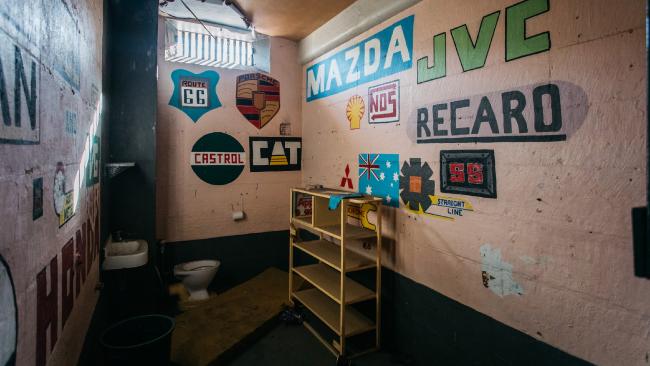
This cell was obviously home for a rev head. Picture: Tim Frawley for news.com.auSource:news.com.au
The dark isolation cells in the basement have no light at all. Standing in the doorway of one pitch-black cell and looking in, it’s so claustrophobic that I shudder involuntarily. If despair lives anywhere, it’s here.
In one form or another, this jail has been in operation since 1798. Back in 1800s, executions took place outside for the public to witness.
More than a century later, Parramatta inmates were killing each other. Government records show that in the two years from 1981-82, four prisoners were murdered here.
The historic building was only decommissioned in 2011 and despite the dust and grime, it’s as if the prisoners who lived here just walked out. Their names and cell numbers are written on a whiteboard on the wall.
Bottles of half-used mouthwash and cracked bars of soap are sitting on hand basins in many cells.
Books from the prison library — including an intact copy of Joseph Heller’s classic novel “Catch 22” — are scattered on the floor or left open on decaying metal bunk beds. A pair of near-new size ten workers boots sits on a shelf.
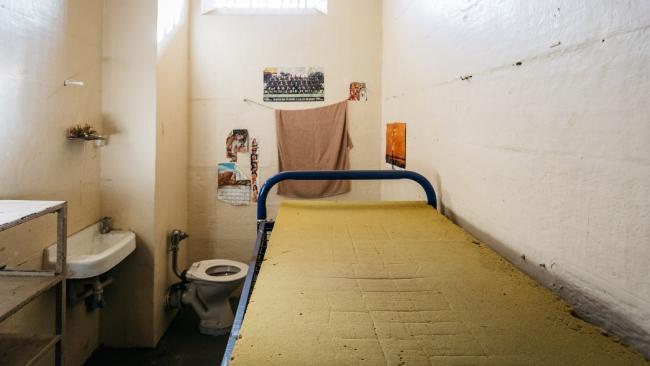
The cells have been left as they were. Picture: Tim Frawley for news.com.auSource:news.com.au
One cell has “Barber Shop” written on the door and alarmingly, human hair lies in dark clumps on the ground alongside an upright broom.
Even the cells on the upper floors — measuring 3 by 4 metres — are only lit by a small, high grate in the wall.
A brochure about the prison describes the facility as “infested with rats” and lists numerous dangerous inmates previously housed here: Escape artist and bank robber Darcy Dugan, stand over man John Frederick ‘Chow’ Hayes, murderer, rapist and drug dealer Arthur Stanley ‘Neddy’ Smith and double murderer Tony Lanigan.
Along with six other men, Lanigan gained national notoriety for nearly pulling off the most daring prison escape in Australia’s history. One of the men who helped dig the extraordinary escape tunnel was Michael Murphy, who would go on to take part in the 1986 rape and murder of nurse Anita Cobby.
We’re physically relieved to step outside into the sunny, concrete exercise yard.
As we keep walking, the security guard points to where the notorious group of caged-in cells — known as “The Circle” — used to house unmanageable inmates. This part of the prison was demolished in the 1990s.
One of Tim Frawley’s pastimes is to take photos of abandoned buildings — just like he is today.
“A lot of the places that are abandoned, they do have an eerie, creepy feeling about them. I’ve been in some where I’ve freaked myself out,” he says.
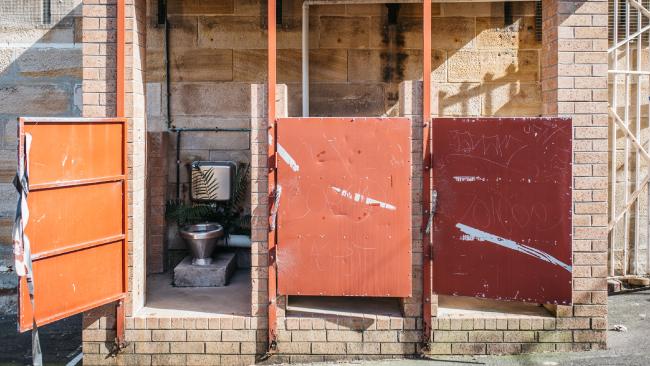
The outdoor lavatories. Picture: Tim Frawley for news.com.auSource:news.com.au
When Tim goes exploring empty structures, it can be hard to know if his mind playing tricks on him. He’s often prompted to question: “Did I hear that or was I imagining that I heard that, because I think there’s something here?”
Tim isn’t the only one who sees artistic merit in this site. Over the years, film and TV directors have shot numerous shows at Parramatta, including The Convict, Underbelly, Home and Away, Packed To The Rafters, Rake, Redfern Now, and SBS comedy Housos.
The former Parramatta Correctional Centre is not open to the public but one thing is clear — it’s unlikely to stay in its current form.
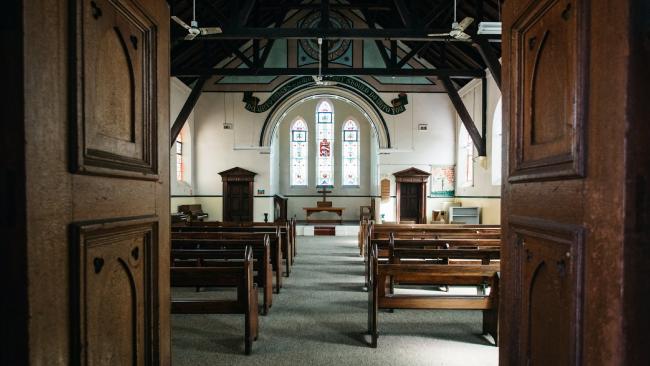
The Parramatta prison chapel. Picture: Tim Frawley for news.com.auSource:news.com.au
The Gaol was the subject of a successful land claim by the Deerubbin Local Aboriginal Land Council and will be transferred to organisation next month. Representatives from the Council did not respond to requests for information about the future plans for the site.
Brian Powyer is president of the Parramatta and District Historical Society and frequently gives community talks about the prison.
He describes the site as “ … an immensely important site because of its structural form but also as a leading example of colonial jail architecture.
“Many subsequent Australian prisons were based on its design,” Brian says.
Mr Powyer is hopeful the heritage value of site will be preserved.
As we wind up our strange visit, the prison chapel is one of the last stops. It boasts polished dark wood pews, beautiful and intact stained glass windows and piles of hymnbooks — and seems frankly implausible in a place like this.
On a high arch above the pulpit are inscribed the biblical words: “Do unto others as ye would they should do unto you.”
If you know who Baby Joe Redmond is or have stories to tell about the prison, send Ginger an email: gingergormanwrites@gmail.com
Find more photos of abandoned buildings at Tim’s website
Ginger Gorman is an award winning print and radio journalist, and a 2016 TEDx Canberra speaker. Follow her on Twitter @GingerGorman






































